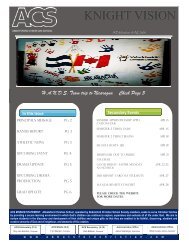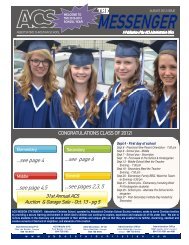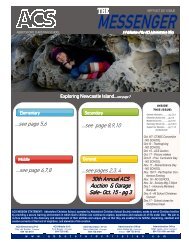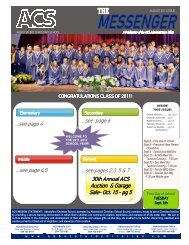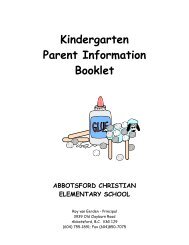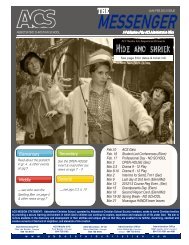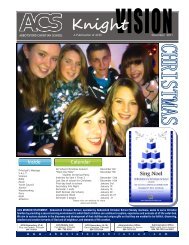Science Curriculum Map Grades K â 12 - Abbotsford Christian School
Science Curriculum Map Grades K â 12 - Abbotsford Christian School
Science Curriculum Map Grades K â 12 - Abbotsford Christian School
- No tags were found...
You also want an ePaper? Increase the reach of your titles
YUMPU automatically turns print PDFs into web optimized ePapers that Google loves.
Planning for Assessment (Teaching Strategies), Assessment Indicators (Assessment Activities) and resources are listed in course overviews<br />
Grade Essential Questions/Unit Questions Content / Enduring Understandings Learning Outcomes: By the end of grade level, the students will: Special Events:<br />
Field Trips, Service Projects, Speakers,<br />
Culminating Activities, etc.<br />
Physics<br />
11<br />
Overall:<br />
How do Physicists view the world<br />
How should we view the world Where is the<br />
connection to meaning<br />
What is the difference between naming<br />
something (describing it) and knowing it<br />
Kinematics:<br />
How are position, velocity, and acceleration<br />
related<br />
Dynamics:<br />
What is the connection between forces and<br />
motion<br />
Universal Gravity:<br />
What creates force between objects that do<br />
not touch<br />
Energy:<br />
What is energy and how does it relate to<br />
forces and motion<br />
Momentum:<br />
What other properties (other than forces and<br />
energy) control how objects interact (collide)<br />
Light:<br />
What is the nature and properties of light<br />
Measurement and Graphing<br />
Error and uncertainty<br />
Representing data graphically<br />
Kinematics<br />
Displacement, velocity, and acceleration in 1-D<br />
Graph and compare dist vs. t, vel vs. t, and accel vs. t<br />
Average vs instantaneous velocity and speed<br />
Projectile motion<br />
Dynamics<br />
Newton’s Law<br />
Friction<br />
Circular motions<br />
Universal gravitation<br />
Elastic forces<br />
Energy<br />
Work, potential energy, kinetic energy<br />
Conservation of energy<br />
Power and efficiency<br />
Momentum – elastic and in-elastic collisions<br />
Thermal energy<br />
Light and Optics<br />
Properties of waves and light<br />
Reflection, refraction, diffraction, dispersion<br />
Doppler effect and polarization<br />
Special Relativity<br />
Reference frames<br />
Influences on time, length, and mass<br />
Skills, Methods, and Nature of Physics<br />
A1 describe the nature of physics<br />
A2 apply the skills and methods of physics<br />
Wave Motion and Geometrical Optics<br />
B1 analyse the behaviour of light and other waves under various conditions, with<br />
reference to the properties of waves and using the universal wave equation<br />
B2 use ray diagrams to analyse situations in which light reflects from plane and curved<br />
mirrors<br />
B3 analyse situations in which light is refracted<br />
Kinematics<br />
C1 apply knowledge of relationships between time, displacement, distance, velocity, and<br />
speed to situations involving objects in one dimension<br />
C2 apply knowledge of the relationships between time, velocity, displacement, and<br />
acceleration to situations involving objects in one dimension<br />
Forces<br />
D1 solve problems involving the force of gravity<br />
D2 analyse situations involving the force due to friction<br />
D3 apply Hooke’s law to the deformation of materials<br />
Newton’s Laws<br />
E1 solve problems that involve application of Newton’s laws of motion in one dimension<br />
Momentum<br />
F1 apply the concept of momentum in one dimension<br />
Energy<br />
G1 perform calculations involving work, force, and displacement<br />
G2 solve problems involving different forms of energy<br />
G3 analyse the relationship between work and energy, with reference to the law of<br />
conservation of energy<br />
G4 solve problems involving power and efficiency<br />
Special Relativity<br />
H1 explain the fundamental principles of special relativity<br />
Labs<br />
Special Relativity:<br />
What did Einstein "discover"<br />
What properties do light and God share<br />
Nuclear Fission and Fusion<br />
I1 analyse nuclear processes



